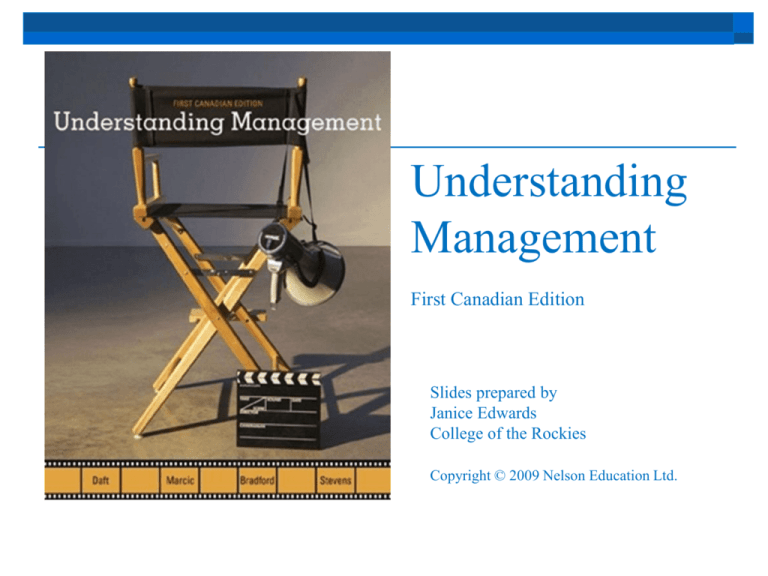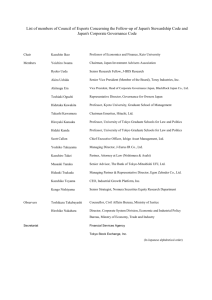Chapter 09 Managerial Decision Making
advertisement

Understanding Management First Canadian Edition Slides prepared by Janice Edwards College of the Rockies Copyright © 2009 Nelson Education Ltd. Chapter 6 Managerial Decision Making and Information Technology 6-2 Learning Objectives 1. 2. 3. 4. Explain the difference between programmed and non programmed decisions and the decision characteristics of risk, uncertainty, and ambiguity. Describe the classical, administrative, and political models of decision making and their applications. Explain why decision making is an important component of good management. Identify the six steps used in managerial decision making. Copyright © 2009 Nelson Education Ltd. 6-3 Learning Objectives (contd.) 5. 6. 7. 8. 9. Explain four personal decision styles used by managers. Discuss the advantages and disadvantages of participative decision making. Identify techniques for improving decision making in today’s turbulent environment. Describe the importance of information technology (IT) for organizations and the attributes of quality information. Discuss IT trends that affect the workplace. Copyright © 2009 Nelson Education Ltd. 6-4 Decisions and Decision Making • A decision is a choice made from available alternatives. • Decision making is the process of identifying problems and opportunities and then resolving them. Copyright © 2009 Nelson Education Ltd. 6-5 Types of Decisions Programmed decisions • situations that occur often enough to enable decision rules to be developed. Nonprogrammed decisions • are made in response to situations that are unique, are poorly defined and largely unstructured. Copyright © 2009 Nelson Education Ltd. 6-6 Decision Making Conditions Certainty • All of the information the decision maker needs is fully available Risk • A decision has clear goals and good information is available, but the future outcomes associated with each alternative are subject to chance. Copyright © 2009 Nelson Education Ltd. 6-7 Decision Making Conditions (Cont’d) Uncertainty • Managers know which goals they wish to achieve. • Information about alternatives and future events is incomplete. • Managers may have to come up with creative approaches to alternatives. Copyright © 2009 Nelson Education Ltd. 6-8 Decision Making Conditions (Cont’d) Ambiguity • The goals to be achieved or the problem to be solved is unclear • Alternatives are difficult to define • Information about outcomes is unavailable. Copyright © 2009 Nelson Education Ltd. 6-9 Ex. 6.1 Conditions That Affect the Possibility of Decision Failure Organizational Problem Low Possibility of Failure Certainty Risk Uncertainty Programmed Decisions High Ambiguity Nonprogrammed Decisions Problem Solution Copyright © 2009 Nelson Education Ltd. 6-10 Three Decision Making Models Classical Model Administrative Model Political Model Copyright © 2009 Nelson Education Ltd. 6-11 Selecting a Decision Making Model Depends on: • The manager’s personal preference. • Whether the decision is programmed or nonprogrammed. • The extent to which the decision is characterized by risk, uncertainty, or ambiguity. Copyright © 2009 Nelson Education Ltd. 6-12 Classical Model • • Based on economic assumptions Is considered to be normative Copyright © 2009 Nelson Education Ltd. 6-13 Assumptions of the Classical Model • • • • Accomplishes goals that are known and agreed upon. Strives for certainty by gathering complete information. Criteria for evaluating alternatives are known. Decision maker is rational and uses logic. Copyright © 2009 Nelson Education Ltd. 6-14 Administrative Model • • How managers actually make decisions in situations characterized by non-programmed decisions, uncertainty, and ambiguity. Two concepts are instrumental in shaping the administrative model: • Bounded Rationality: people have limits or boundaries on how rational they can be. • Satisficing: decision makers choose the first solution alternative that satisfies minimal decision criteria. Copyright © 2009 Nelson Education Ltd. 6-15 Political Model • • • • • Closely resembles the real environment in which most managers and decision makers operate. Decisions are complex. Information is often ambiguous. Disagreement and conflict over problems and solutions are normal. Coalition building is important. Copyright © 2009 Nelson Education Ltd. 6-16 Ex. 6.2 Characteristics of Classical, Administrative, and Political Decision-Making Models Classical Model Administrative Model Political Model Clear-cut problem and goals. Vague problem and goals. Pluralistic; conflicting goals. Condition of certainty. Condition of uncertainty. Condition of uncertainty/ambiguity. Full information about alternatives and their outcomes. Limited information about alternatives and their outcomes. Inconsistent viewpoints; ambiguous information. Rational choice by individual for maximizing outcomes. Satisficing choice for resolving problem using intuition. Bargaining and discussion among coalition members. Copyright © 2009 Nelson Education Ltd. 6-17 Ex. 6.3 Six Steps in the Managerial Decision Making Process Copyright © 2009 Nelson Education Ltd. 6-18 Ex. 6.5 Personal Decision Framework Situation: · Programmed/non-programmed · Classical, administrative, political · Decision steps Copyright © 2009 Nelson Education Ltd. Personal Decision Style: ·Directive ·Analytical ·Conceptual ·Behavioural Decision Choice: ·Best Solution to Problem 6-19 The Vroom-Jago Model The Vroom-Jago Model helps gauge the appropriate amount of participation for subordinates, based on: • • • leader participation styles a set of diagnostic questions with which to analyze a decision situation a series of decision rules. Copyright © 2009 Nelson Education Ltd. 6-20 Vroom-Jago Model: Diagnostic Questions 1. 2. 3. 4. 5. 6. 7. Decision significance Importance of commitment Leader expertise Likelihood of commitment Group support for goals Group expertise Team competence Copyright © 2009 Nelson Education Ltd. 6-21 New Decision Approaches for Turbulent Times 1. 2. 3. 4. 5. Start with brainstorming. Learn; do not punish. Know when to bail. Practise the 5 Whys. Engage in rigorous debate. Copyright © 2009 Nelson Education Ltd. 6-22 Management Implications of Information Technology • Improved employee effectiveness. • Increased efficiency. • Empowered employees. • Information overload. • Enhanced collaboration. Copyright © 2009 Nelson Education Ltd. 6-23







